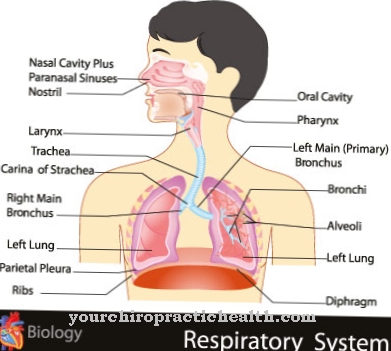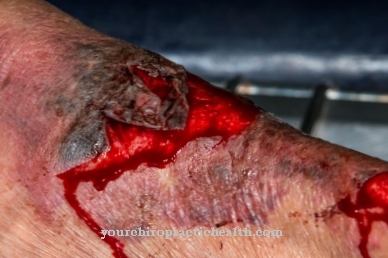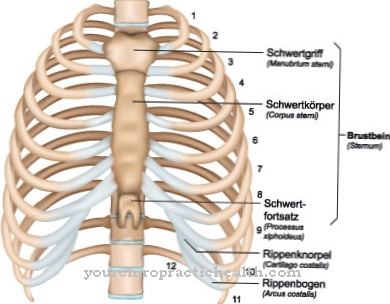Numerous people will suffer from hip discomfort from one in their lifetime Hip osteoarthritis. This significantly limits their quality of life. The resulting effects also impair the performance of a professional work to a considerable extent. This also causes significant economic damage.
What is hip osteoarthritis?

Hip arthrosis is a disease of the hip joint in which the cartilage layer between the acetabulum and the femoral head shows signs of wear. The wear and tear is mostly age-related. But it can also occur due to injury or illness. As a protective smear layer, the cartilage tissue prevents the bones from rubbing against each other painfully and grinding themselves off in the process.
The cartilage mass is an elastic connective tissue that has a water-storing property. The natural aging process reduces elasticity and water storage. Analogous to the visible skin changes caused by the formation of wrinkles, there is also a change inside the body. The articular cartilage becomes smaller and rougher. The loss of cartilage height also causes a reduction in the absorption capacity.
The progression of this degenerative development process causes a functional limitation of the hip joint. In addition, there is increasing pain when the affected joint is loaded. The duration and intensity of the pain can vary. The symptoms can even temporarily subside before pain recurs, which subsequently occurs at night even without stress.
causes
The cause of hip arthrosis can be of various types and cannot always be clearly diagnosed. In the majority of cases, the natural aging process is the cause of the disease. Hereditary factors such as congenital deformities can accelerate this process.
In addition, diseases such as rheumatism, gout, bacterial infections as well as femoral head necrosis and osteoporosis can be the causal cause of coxarthrosis. Accidents can also lead to hip osteoarthritis. A pelvic fracture or a fracture of the femoral neck with a joint impairment can trigger the onset of the disease. This changes the natural statics of the joint and causes greater stress on the cartilage.
Medicines can also be responsible for osteoarthritis of the hip joint. Persistent, one-sided overloading of the hip joint can promote hip arthrosis over a longer period of time. Significant, long-term obesity also leads to this overload effect. Another cause of hip osteoarthritis can be a lack of exercise, which leads to poor blood flow to the cartilage. The production of cartilage smear is reduced by a disruption of the passive metabolism.
Symptoms, ailments & signs
Hip osteoarthritis begins with hardly noticeable symptoms. At the beginning there is slight pain, which is particularly noticeable by those affected during exercise. After a short time, the pain occurs even when the patient is resting. Activities such as getting out of the car or climbing stairs are becoming increasingly difficult and are ultimately no longer possible at all.
Then the joints hurt even at rest and at night and the pain often radiates to the knees and lower back. Arthrosis of the hip joints manifests itself primarily as starting pain in the hip area, which subsides after a few steps. In the advanced stage, joint pain, groin pain and pain at rest occur.
The mobility of the thighs is severely restricted - often the legs can only be bent, stretched or spread with great effort. Outwardly, hip osteoarthritis can be noticed in the sluggish, often rocking gait. Those affected move much more slowly than usual and also have to take regular breaks.
In individual cases, hip osteoarthritis can manifest itself as redness and swelling in the hip area. In addition to the physical symptoms, psychological complaints such as increased irritability or depressive moods usually occur.
Diagnosis & course
Restrictions in hip function, which are often accompanied by painful sensations in the leg, back or buttocks, indicate that hip arthrosis has started. If osteoarthritis is suspected, a detailed questioning of the patient's lifestyle and previous history is first carried out in order to find out possible hereditary factors, overloads, injuries or nutritional errors.
This is followed by a physical examination to determine hip mobility. Existing misalignments in the joint and swelling of the capsule can already be felt. With the help of targeted examination techniques, movement-dependent pain can also be specifically determined. Further information can be obtained from imaging examination methods. X-rays provide an informative representation of the hip joint in several planes.
The detection of changes in the joint space is a clear indication of cartilage wear. In addition, an ultrasound examination to support the visualization of the soft tissues can be helpful in establishing the diagnosis. Magnetic resonance imaging or hip arthroscopy using a small camera probe provides specific, precise information about the distribution and vitality of the articular cartilage.
A blood test must be carried out to determine whether a bacterial infection could be the cause of the hip arthrosis. If hip osteoarthritis causes start-up pain, for example after getting up in the morning or after sitting for a long time, this pain and stiffness usually disappear after some movement.
If the disease is advanced, only shorter distances can be covered. There may also be a limp while walking. The pain occurs more and more frequently as overuse pain and ultimately also occurs in a state of rest. As the cartilage wear progresses, hip stiffness finally occurs.
Complications
The hip osteoarthritis causes pain and limits the patient's movement. The quality of life is significantly reduced by the disease and the everyday life of the person affected is made more difficult. In most cases, certain activities or your own work can no longer be carried out. These restrictions often lead to mental illness or depression.
Hip osteoarthritis mainly causes pain in the hips and joints. This pain can also spread to other regions of the body and thus lead to pain in the back, for example. It is not uncommon for patients to suffer from gait disorders and severe restrictions in everyday life. Some sufferers need a walking aid or are dependent on other people in their everyday life if this is restricted by hip osteoarthritis.
Furthermore, the pain can also occur at night in the form of rest pain and lead to sleep problems. Hip arthrosis can be treated in various ways and the symptoms can be alleviated. There are no further complications. As a rule, the treatment is causal, so that patients who are overweight, for example, have to reduce it first. Prostheses can also be used. Life expectancy is not reduced by this disease.
When should you go to the doctor?
If you notice hip or joint pain that increases in intensity over time, it may be due to hip osteoarthritis. A doctor should be consulted when the symptoms first arise. If gait disorders or other movement restrictions occur, a serious illness can be assumed, which must be clarified promptly. The person concerned should speak to the family doctor quickly and consult an orthopedic surgeon for further clarification.
If there is pain even with light physical exertion, a doctor must be consulted on the same day. Patients suffering from rheumatism, gout or osteoporosis are particularly prone to developing hip osteoarthritis. Likewise people who have had a severe bacterial infection or who suffer from femoral head necrosis. Medication, a lack of exercise and a generally unhealthy lifestyle are also possible triggers of the disease. Anyone who belongs to these risk groups should see a doctor immediately with the symptoms mentioned. In case of doubt, the emergency medical service can be contacted first.
Doctors & therapists in your area
Treatment & Therapy
Hip osteoarthritis can be treated with joint-preserving therapy or joint replacement, depending on the patient's findings. In the case of joint-preserving therapy, the previous cartilage wear should be significantly reduced. In addition, regeneration of the joint surfaces and cartilage growth should be achieved.
If the patient is significantly overweight, it is always advisable to diet and switch to a balanced diet. In the case of one-sided, permanent overloading of the hip joint or insufficient movement, behavioral corrections must also be made. If the medication you have taken has caused the osteoarthritis, you must stop. On the other hand, taking pain relievers and anti-inflammatory drugs can be helpful and soothing.
Technical measures such as orthopedic shoes, crutches or bandages can also be beneficial for treating the disease by changing the load and misalignment. Physical treatment measures such as heat or cold therapy and physiotherapy can also have a supportive effect. Injection therapy with hyaluronic acid can be effective for temporary relief of symptoms.
At an advanced stage of the disease, only surgical measures can help. Limited cartilage damage can often be repaired by hip arthroscopy. Broken pieces of cartilage are removed so that they cannot cause further abrasion. In addition, the roughened, torn cartilage is smoothed. This calms the synovial membrane and the hip problems subside. If the joint destruction is more advanced, the joint is replaced by hip prostheses as part of an operation. Cementless or cemented prostheses can be used.
prevention
A number of preventive measures can be taken to address the causes. Reducing body weight by five kilograms can reduce the risk of osteoarthritis by almost 50 percent in a severely overweight person.
The diet should be high in green vegetables and low in red meat. Pleasure poisons should be avoided entirely. A reasonable load on the hip joint at work and during sport as well as targeted gymnastic exercises or swimming are sensible prevention measures. Bad posture and excessive strain should be avoided. Typical restrictions on movement and pain should be noted early on and examined by a doctor.
Especially in old age, many people suffer from hip arthrosis, in which the cartilage layer wears out. This leads to painful restrictions on movement. If this development process cannot be stopped, only a joint replacement will help.
Aftercare
In the case of hip osteoarthritis, comprehensive medical treatment is required first. Follow-up care includes regular doctor visits. The specialist in charge will first examine the hips and talk to the patient. This enables him to get an idea of how the disease is progressing and, if necessary, to take further steps. The medication often has to be adjusted or another operation initiated.
Long-term treatment is therefore necessary for chronic diseases. Individual symptoms such as the start-up pain or the typical joint and groin pain require extensive follow-up care. Persistent pain can be relieved through physical therapy or simpler measures such as acupuncture and massage.
These practices mostly serve as support when conservative treatment options have been exhausted. If the disease progresses negatively with persistent walking difficulties and poor posture, appropriate preparations must be made.The patient needs aids such as crutches, and it often happens that the job has to be changed and changes in the household have to be made.
The orthopedic surgeon or family doctor responsible will take care of hip osteoarthritis. After a surgical procedure, you should also consult the attending surgeon. To begin with, a doctor should be seen every two weeks. If he does not find any complications, the appointments can be reduced to every month, then to every three months and finally to every six months.
You can do that yourself
To avoid additional pain or severe progression of the disease, overloading and overstressing the skeletal system should be avoided. Carrying or lifting heavy objects should be avoided. When it comes to shoes, make sure that they don't have high heels or are too tight. A rigid posture for a long time is also not beneficial to health. Balancing movements and the correction of one-sided body positions are helpful to alleviate the discomfort. The hips, pelvis and back must be adequately protected from the effects of cold and drafts.
Those affected should observe and observe their own stress limit in the case of osteoarthritis. Sports activities are to be oriented towards this, but if possible not completely stopped. The body weight must be kept in the normal range. A healthy and balanced diet helps to strengthen the skeleton and stabilize the immune system. For activities while seated, make sure that you sit in an ergonomic position. At the same time, sleep hygiene must be optimized for a balanced night's sleep. The body needs sufficient rest and recovery phases, which should be firmly integrated into everyday life.
With selected physiotherapy exercises, the skeletal system can be supported and the symptoms alleviated. The training units are to be carried out regularly and as specified by trained personnel.






.jpg)






.jpg)

.jpg)
.jpg)











.jpg)